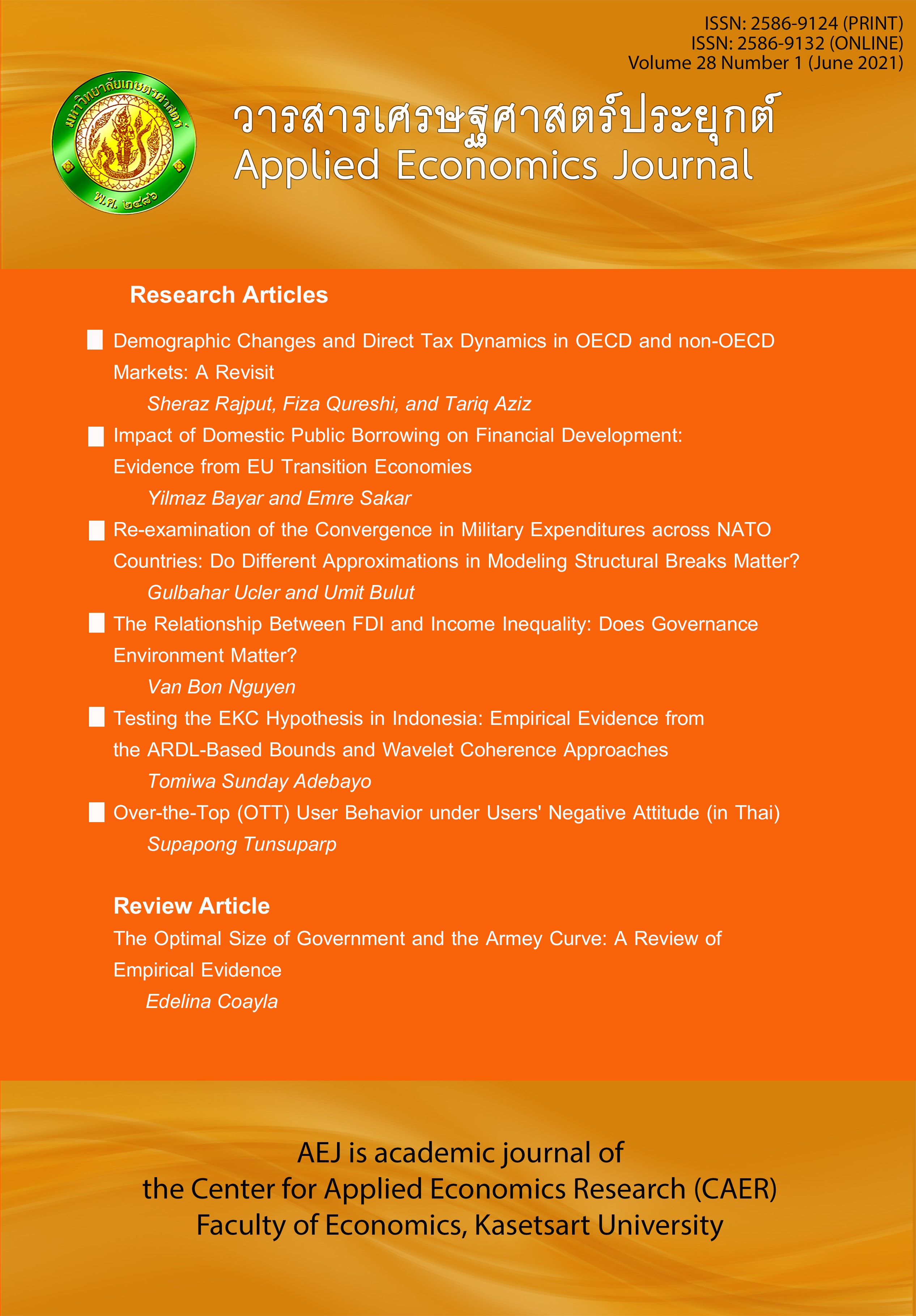พฤติกรรมการใช้บริการ Over-the-Top (OTT) ภายใต้ทัศนคติทางลบของผู้ใช้งาน
Main Article Content
บทคัดย่อ
การใช้บริการ Over-the-Top (OTT) นั้นเติบโตขึ้นอย่างมากในประเทศไทย จากการศึกษาพฤติกรรมการใช้งานก่อนหน้า พบว่ามีการนำปัจจัยทางลักษณะของผู้ใช้งานและทัศนคติด้านบวกมาใช้ในการศึกษาผลกระทบต่อการใช้บริการแต่ยังขาดงานที่ศึกษาผลของทัศนคติด้านลบต่อการใช้งาน งานวิจัยชิ้นนี้จึงต้องการศึกษาผลของทัศนคติด้านลบที่มีต่อพฤติกรรมการใช้งาน โดยพิจารณาผ่านแนวคิดด้านความเอนเอียงทางพฤติกรรมของมนุษย์ซึ่งอาจส่งผลให้การใช้งานไม่สมเหตุสมผลได้ ข้อมูลที่ใช้ในการศึกษาครั้งนี้ เป็นข้อมูลที่เก็บรวบรวมโดยสำนักงาน กสทช. จากผู้ใช้บริการ OTT ในประเทศไทย โดยศึกษาผ่านแบบจำลองถดถอยเชิงเส้นหลายตัวแปร ผลการศึกษาพบว่าจากการทดสอบทัศนคติทางลบเด่น ๆ จากการใช้งาน มีเพียงทัศนคติด้านผลเสียต่อปฏิสัมพันธ์กับคนรอบข้างที่ส่งผลให้ปริมาณการใช้งานลดลง ขณะที่จากการศึกษารายจ่ายในการใช้งาน พบทัศนคติทางลบสองด้านที่ทำให้รายจ่ายในการใช้งานลดลงอย่างมีนัยสำคัญ ได้แก่ ทัศนคติด้านการพักผ่อนไม่เพียงพอ และการเกิดอาชญากรรมได้ง่าย ซึ่งอาจสะท้อนความเอนเอียงทางพฤติกรรมของมนุษย์ที่เกิดขึ้นจากความสามารถในการควบคุมตนเอง หรือการปรับตัวเพื่อเคยชินกับผลกระทบทางลบที่เกิดขึ้น โดยหน่วยงานที่เกี่ยวข้องสามารถออกแบบการสื่อสารด้านผลกระทบทางลบเพื่อช่วยในการปรับพฤติกรรมผู้ใช้งาน OTT ได้
Article Details
The paper is published under CC BY-NC-ND, in which the article is freely downloaded and shared in its original form non-commercially and its citation details are identified.
References
Adriaanse, M. A., Kroese, F. M., Gillebaart, M., & De Ridder, D. T. D. (2014). Effortless inhibition: Habit mediates the relation between self-control and unhealthy snack consumption. Frontiers in Psychology, 5(444), 1-6.
Bondad-Brown, B. A., Rice, R. E., & Pearce, K. E. (2012). Influences on TV viewing and online user-shared video use: Demographics, generations, contextual age, media use, motivations, and audience activity. Journal of Broadcasting & Electronic Media, 56(4), 471-493.
Cambridge Mobile Telematics. (2019). Connected Insurance Italy Market Survey 2019. Retrieved from https://www.cmtelematics.com/news/distracted-on-your-cell-phone-cambridge-mobile-telematics-tells-us/
Cartwright, E. (2018). Behavioral economics (3rd ed.). New York: Routledge.
Cho, H.-Y., Kim, D. J., & Park, J. W. (2017). Stress and adult smartphone addiction: Mediation by self-control, neuroticism, and extraversion. Stress Health, 33(5), 624-630.
Ericsson ConsumerLab. (2017). TV & Media 2017 A Consumer-Driven future of media. Retrieved from https://www.ericsson.com/assets/local/networked-society/consumerlab/reports/tv_media_2017_global_presentation.pdf
Gathergood, J. (2012). Self-control, financial literacy and consumer over-indebtedness. Journal of economic psychology, 33(3), 590-602.
Kim, S. J. (2016). A repertoire approach to cross-platform media use behavior. New Media and Society, 18(3), 353-372.
Kim, K. T., Lee, J. M., & Hong, E. O. (2013). Assessing the effect of self-control on retirement preparedness of US households. Consumer Interests Annual, 59, 1-6.
Kim, M. S., Kim, E., Hwang, S., Kim, J., & Kim, S. (2017). Willingness to pay for over-the-top services in China and Korea. Telecommunications Policy, 41(3), 197-207.
Lee, B., Fraser, I., & Fillis, I. (2017). Nudging art lovers to donate. Nonprofit and Voluntary Sector Quarterly, 46(4), 837-858.
Lee, C. C., Nagpal, P., Ruane, S. G., & Lim, H. S. (2018). Factors affecting online streaming subscriptions. Communications of the IIMA, 16(1), 1-25.
Lee, S.-E., Choi, M., & Kim, S. (2019). They pay for a reason! the determinants of fan’s instant sponsorship for content creators. Telematics and Informatics, 45, 101286.
Medina, M., Herrero, M., & Portilla, I. (2019). The evolution of the pay TV market and the profile of the subscribers. Revista Latina de Comunicación Social, 74, 1761-1780.
Netsanity. (2017). 5 surprising physical dangers of smartphone addiction. Retrieved from https://netsanity.net/smartphone-addiction/
Office of the NBCT. (2018). The analytical report in OTT industry and TV market in Thailand and future directions. Bangkok: Office of the National Broadcasting and Telecommunication Commission. (In Thai)
Office of the NBCT. (2019). OTT video subscription forecast, comparative study on OTT services in Thailand & global markets (2019-2023). (In Thai) Retrieved from https://broadcast.nbtc.go.th/data/academic/file/620800000002.pdf
Srinuan, C. (2015). Over-the-Top (OTT): Beginning of war in the new ICT ecosystem. Information Technology Journal, 11(1), 74-81. (In Thai)
Taneja, H., Webster, J., Malthouse, E., & Ksaizek. (2012). Media consumption across platforms: Identifying user-defined repertoires. New Media and Society, 14(6), 951-968.
Tangney, J. P., Baumeister, R. F., & Boone, A. L. (2004). High self-control predicts good adjustment, less pathology, better grades, and interpersonal success. Journal of Personality, 72(2), 271-324.
Thaler, R. H., & Shefrin, H. M. (1981). An economic theory of self-control. Journal of political Economy, 89(2), 392-406.
Wang, C. L., Zhang, Y., Ye, L. R., & Nguyen, D. (2005). Subscription to fee-based online services: What makes consumer pay for online content? Journal of Electronic Commerce Research, 6(4), 304.

